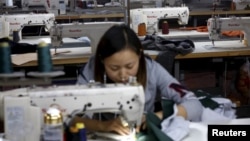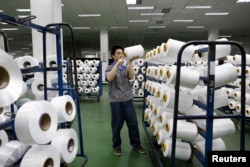The slowdown of the Chinese economy may have a bigger impact than Brexit on Southeast Asia, as many of its neighbors are reliant on trade with China for growth. And while many are feeling the impact of that slowdown, the region's growing middle class is helping to act as a buffer.
China's Gross Domestic Product (GDP) expanded 6.7 percent in the first quarter, the slowest reading since the global financial crisis in early 2009.
Joseph Incalcaterra, an economist with HSBC, said, “From 2000 to 2005 and then comparing from 2006 to 2014, what we found was in the first period, the U.S. or even the EU, was a more important driver of export growth in Asia, and in the most recent period it is actually China across the board, from a sensitivity perspective. The slowing growth in China, even though we don’t forecast a hard landing, what we’re seeing is a gradual occurrence that is actually weighing down exports in the rest of the region.”
Growing middle class helps
Southeast Asia has a collective GDP of $2.6 trillion. In 2015, growth slowed in seven of 10 members of the Association of Southeast Asian Nations, or ASEAN. Hardest hit was Indonesia, which exports large volumes of commodities to China.
While Southeast Asia’s exports may be slowing in parallel with Chinese demand, the region’s young population and growing middle class may propel Southeast Asia to be a driver of growth in the region.
Earlier this year the Asia Development Bank predicted economic expansion in Southeast Asia would rise 4.5 percent in 2016 and 4.8 percent next year. That’s up from a 4.4 percent rate of expansion in 2015. Six-hundred-twenty-million people live in the region, and 25 percent of trade is with other Southeast Asian nations, providing a buffer to China’s slowdown.
Le Hong Hiep, a visiting fellow at the ISEAS-Yusof Ishak Institute in Singapore, said, “I haven’t seen a lot of impacts of China’s economic slowdown on Vietnam. In 2015 for example, Vietnam’s exports to China kept growing, 14.8 percent, and I think it’s because Vietnam’s exports to China are mainly composed of raw materials, and agricultural products, which are not really impacted by the economic slowdown in China.”
US, others investing more in Southeast Asia
Despite broad changes in political leadership and recent elections in the Philippines, Myanmar, Vietnam and Laos, investment from China, India, Russia and the U.S. is pouring into Southeast Asia. Trade between the U.S. and Vietnam rose to $45 billion in 2015, and U.S. President Barack Obama is pushing for a Trans Pacific Partnership (TPP), a trade agreement between the U.S. and 11 Pacific Rim nations that would provide a counterbalance to China’s economic influence and continue to support growth in the region.
Brian Eyler, deputy director of the Stimson Center’s Southeast Asia Program, said, “We see the U.S. investing more in Southeast Asia, training more, restructuring its diplomatic architecture, to better integrate with Southeast Asia. India is doing the same; Russia is doing the same. So they’re playing on the fact that ASEAN and Southeast Asia is a fast growing area. There’s a lot of existing infrastructure there that is sitting idle as a result of China’s economic slowdown, and no one wants to see that go to waste.”
Supporters of the TPP hope the agreement will win approval in a lame-duck vote in U.S. Congress late this year.









